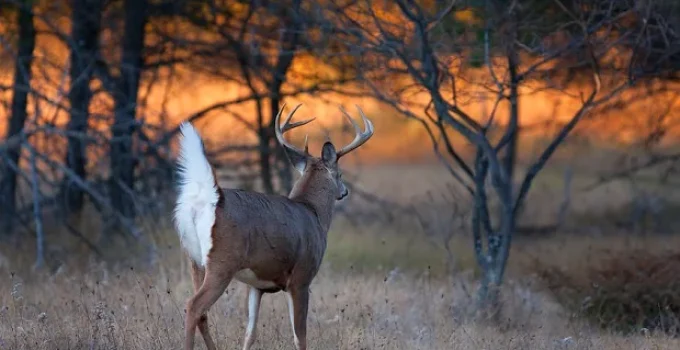Are Deer Nocturnal?
Deer are not strictly nocturnal—they are primarily crepuscular, meaning they are most active during dawn and dusk. However, they can shift to more nocturnal behavior depending on factors like predation, human disturbance, and habitat. Their activity patterns are flexible, helping them adapt to changing conditions and threats.
Dive Deeper
- What Does “Crepuscular” Mean?
- When Are Deer Most Active?
- Why Do Deer Come Out at Night?
- How Moon Phases and Weather Affect Deer Movement
- Do All Deer Species Behave the Same?
- 🎯 Final Thoughts
- 📚 References
🌅 What Does “Crepuscular” Mean?
The term crepuscular refers to animals that are most active during twilight hours—specifically, at dawn and dusk.
For deer, this behavior offers major advantages:
- Reduced exposure to predators
- Lower daytime temperatures for movement
- Increased visibility compared to full darkness
Crepuscular activity also aligns with the movements of their predators (like coyotes and wolves), allowing for easier avoidance.
🕰️ When Are Deer Most Active?
Deer activity follows a rhythmic daily pattern that peaks in the early morning and late evening. Wildlife studies using GPS collars and motion-sensor cameras show:
| Time of Day | Typical Deer Activity Level |
|---|---|
| Early Morning (5–8 AM) | High |
| Midday (11 AM–2 PM) | Low |
| Evening (5–9 PM) | High |
| Late Night (12–3 AM) | Moderate |
📊 Study Highlight: A 2019 study from Mississippi State University found that 75% of deer movement occurred within three hours of sunrise or sunset [1].
🌙 Why Do Deer Come Out at Night?
Though not true nocturnes, deer frequently appear at night—especially in areas with high human activity. Reasons include:
- Avoiding hunters or vehicles
- Reduced risk from daytime predators
- Cooler temperatures in warm climates
- Access to agricultural food sources under cover of darkness
This shift toward nocturnality is often behavioral plasticity—a deer’s way of adapting to its environment rather than an innate trait.
🌕 How Moon Phases and Weather Affect Deer Movement
Deer adjust their behavior in response to moonlight, temperature, and wind:
- Full moon: May reduce deer movement due to increased predator visibility
- Cloudy or rainy days: Can lead to daytime activity
- Windy conditions: Often suppress deer movement due to impaired hearing and smell
| Environmental Factor | Likely Deer Response |
|---|---|
| Full Moon | Decrease in movement |
| Cold fronts | Spike in feeding activity |
| Light rain | Slight increase in movement |
📊 Stat: Research published in The Wildlife Society Bulletin found that deer travel up to 40% farther on cold, overcast days than on hot, sunny days [2].
🦌 Do All Deer Species Behave the Same?
While crepuscular behavior is common across deer species, variations exist:
- White-tailed deer (North America): Strongly crepuscular but often nocturnal in urban areas
- Red deer (Europe): Exhibit diurnal activity in protected environments
- Mule deer (Western U.S.): More prone to mid-morning and mid-afternoon movement in mountainous areas
- Axis deer (India): Active both day and night, but peak at twilight
These differences are influenced by:
- Habitat (open vs. forested)
- Presence of predators
- Human disturbances
- Regional climate
🎯 Final Thoughts
So, are deer nocturnal? Not exactly. Deer are primarily crepuscular, taking advantage of dawn and dusk to feed and move safely. But their behavior is flexible—shaped by moonlight, human activity, and seasonal changes. Whether you’re a wildlife watcher, conservationist, or hunter, understanding when and why deer move is key to encountering them respectfully and responsibly.
📚 References
- Ditchkoff, S. S., & Raglin, J. B. (2019). Temporal patterns of deer movement relative to human activity. Mississippi State University Deer Lab.
- Beier, P., & McCullough, D. R. (1990). Factors influencing white-tailed deer activity patterns and movements. Wildlife Society Bulletin, Link.
- Geist, V. (1998). Deer of the World: Their Evolution, Behavior, and Ecology. Stackpole Books.
